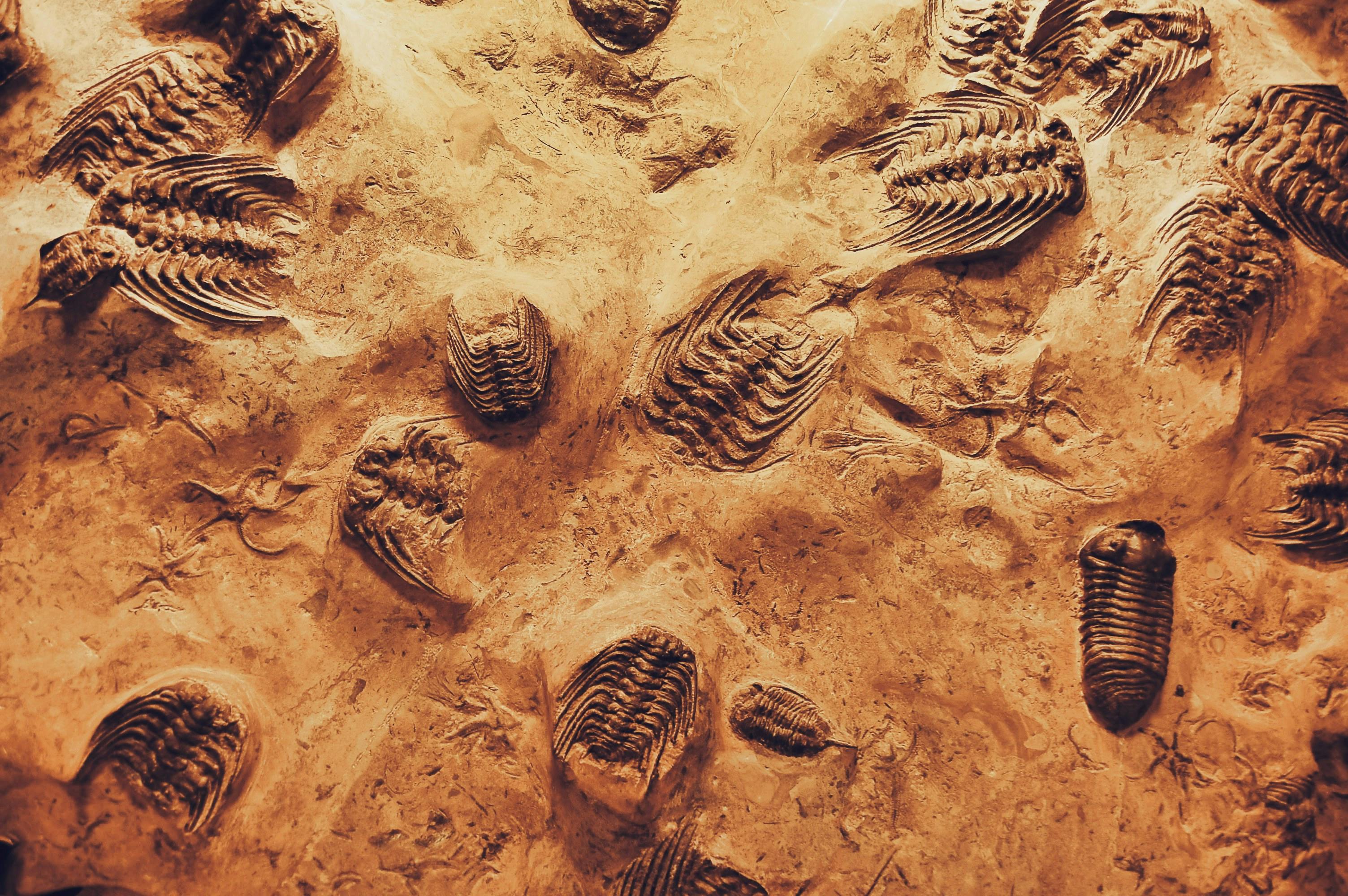Trilobites
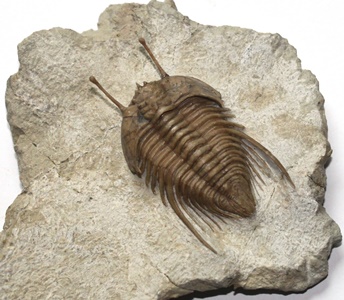
Cybele bellatula from the Ordovician of the Saint Petersburg region.
1.Presentation
Trilobites are exclusively marine Arthropods known only in fossil form. They first appeared in the Early Cambrian (the first period of the Paleozoic or Primary Era) 520 million years ago following the Cambrian Explosion. The Cambrian Explosion refers to a relatively short geological period of approximately 12 million years (from -542 to -530 million years) during which the majority of current multicellular animal phyla appeared, and life forms diversified rapidly and extensively. Within this environment, Trilobites represented one of the most advanced animal forms. Indeed, they were the first to develop true eyes, marking a significant evolutionary leap.
The first Trilobites belonged to the order Redlichiida, followed almost immediately by the order Ptychopariida. The Agnostida and then the Corynexochida also appeared very quickly. Species diversity rapidly reached its peak during the Late Cambrian.
The Cambrian ended with one of the first mass extinctions, giving way to the Ordovician, a period during which new orders such as the Asaphida developed and replaced previous ones. Another mass extinction, caused by a major glaciation, marked the end of this period. This was the Ordovician-Silurian extinction, during which 60% of genera and 85% of species disappeared. Subsequently, during the Silurian period, diversification continued slowly, then more rapidly again during the Devonian.
Several mass extinction events occurred during the Late Devonian. The Phacopida and Proetida were the only two orders, out of the five previously existing, to survive these events. However, the former eventually became extinct, while the Proetida continued to evolve.
During the Early Carboniferous, many new species appeared, but in the Late Carboniferous, this diversity declined sharply, and Trilobites became only a small part of the seafloor fauna before going extinct in the Late Permian during the Permian-Triassic crisis, which led to the disappearance of 95% of marine species and 70% of terrestrial species. The five surviving genera up to this crisis were Pseudophillipsia, Acropyge, Paraphillipsia, Kathwaia, and Cheiropyge.
Throughout the Paleozoic Era, nearly 20,000 species roamed the ocean floors, representing incredible biodiversity and making them highly sought after by specialized collectors today. You can find superb specimens of various Trilobite species from different localities available for sale on our website.

Hoplolichoides conicotuberculatus (NIESZKOWSKI 1859)
2: Morphology and ontogeny
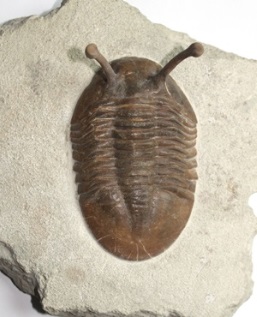
Trilobites owe their name to the fact that their body is divided into three longitudinal parts: the lobes. There is a central (or median) lobe, with two lateral lobes (the pleura) on either side.
The body of Trilobites is also divided into three sections lengthwise: the cephalon, which can be defined as the head of the animal, followed by the thorax, and finally the pygidium, which can be described as the tail.
As mentioned above, Trilobites were evolutionary pioneers due to their highly developed eyes, which appeared immediately in the basal Cambrian. These eyes were crescent-shaped and positioned on either side of the cephalon. However, in species living at depths below the epipelagic zone (where light penetrates deeply enough for photosynthesis to occur), eyes were absent as they became useless.
The thorax consisted of articulated segments, with their number ranging from 2 to over a hundred. The pygidium was also made up of segments, but they were fused, forming a rigid structure that may have aided in swimming. The size of the pygidium varied greatly depending on the species, but in the oldest ones, it remained relatively small. Pygidial spines could sometimes be present at the end of the pygidium. In the case of a single pointed extension, it is called a telson, whereas multiple points are referred to as cerci. Trilobites had a very solid exoskeleton, which they regularly shed during molting. This exoskeleton would separate between the cephalon and the thorax, which is why it is common to find fossils consisting of only one of these parts. Complete fossils of deceased Trilobites are therefore rarer.
They also had a pair of antennae and biramous limbs, like most Arthropods, which were attached to the thorax and pygidium. Limbs are considered biramous when they are divided into two parts or branched.
Many Trilobites had the ability to curl up in response to danger to protect their abdomen, which is why some fossilized specimens are found in this position.
Some species exhibited extreme morphologies with more or less numerous and large horns and spines. Size varied significantly among species, ranging from just 1 millimeter to over 70 centimeters for the giant Isotelus rex from the Ordovician. The largest known specimen of this species measures 72 centimeters and was discovered in Hudson Bay, Canada. The preservation of their exoskeleton from the larval stage allows us to study and understand the development (or ontogeny) of Trilobites, which is divided into three main stages: the larval stage (protaspis), the juvenile stage (meraspis), and the adult stage (holaspis).
Asaphus kowalewskii from the Ordovician period in the St. Petersburg region.
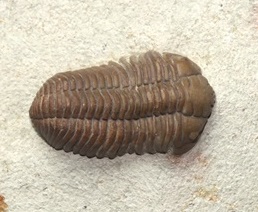
Pliomera fischeri de l'ordovicien de la région de Saint Pétersbourg.
3: Some emblematic deposits
Trilobites are known from a large number of deposits around the world. These date from all periods of the Primary Era, from the Basal Cambrian to the Terminal Permian. We'll take a look at a few of these sites, in chronological order, some of the best known for the Trilobite fauna discovered there.
The Lower Cambrian Lagerstätte of Chengjiang, located in the Hunan province of China, is an exceptional fossil site that has yielded an incredibly diverse fauna from the Cambrian Explosion. Among this fauna are the earliest known Trilobites, such as Eoredlichia intermedia, Kuanyangia pustulosa, Yunnanocephalus yunnanensis, and Wutingaspis tingi. These early Trilobites were preyed upon by the first known major Trilobite predator: Anomalocaris, a genus also belonging to the phylum Arthropoda. Anomalocaris could grow up to 1 meter in length, which was considerable compared to the rest of the Cambrian fauna. However, an even larger relative, Aegirocassis, discovered in the Fezouata Formation of the Anti-Atlas region in Morocco, could reach an impressive length of 2 meters!
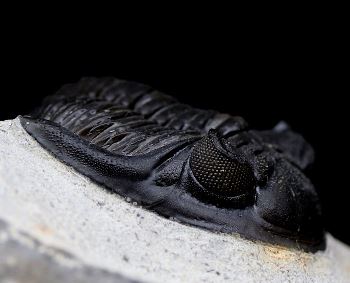
- The Lower and Middle Cambrian of the “Kaili Formation” in Hunan province, China, is also a notable site. The formation is best known for its Lagerstätte dating from the base of the Middle Cambrian. There are 3 distinct zones: the Bathynotus holopygous - Ovatoryctocara granulata zone, the Oryctocephalus indicus zone and the Olenoides jialaoensis zone. Excellent examples of Trilobites from this formation are available for sale on our website. - The Lower and Middle Cambrian “Pioche Formation” in eastern Nevada (USA) features fossiliferous marine deposits with a varied arthropod fauna. These include numerous Trilobites, mostly of the family Olenellidae (order Redlichiida) for the Lower Cambrian levels.
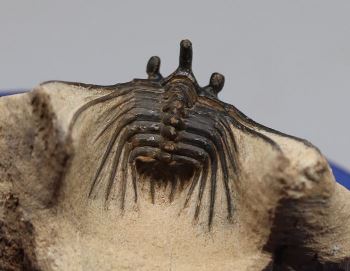
Representatives of the Ptychopariida order are the most common in the Middle Cambrian. Of the 6 members that make up the formation, nearly 50 genera have been recorded. - The Lower and Middle Cambrian “Carrara Formation” of southern Nevada and California (USA) is a deposit located in southeastern Death Valley, where sediments outcrop harbor a rich fauna. Nearly a hundred species of Trilobites have been recorded among the 9 members that make up the formation. These include the Bonnia - Olenellus zone, the Plagiura - Poliella zone, the Albertella zone and the Glossopleura zone. Trilobites of the Bristolia genus are well known here, not least for their distinctive aesthetics.
- The Middle Cambrian “Jince Formation” south-west of Prague in the Czech Republic lies within the “Barradian area” (named after the French geologist and palaeontologist Joachim BARRANDE 1799-1883), which comprises several Lagerstätten from Cambrian to Devonian. The “Jince formation” is the most fossiliferous Cambrian unit in the Barradian area. It outcrops in 2 areas: the “Jince area” and the “Skryje-Tyrovice area”. Trilobites of the Paradoxides, Ellipsocephalus, Hydrocephalus and Conocoryphe genera are well represented.
The orders Agnostida and Ptychopariida are the most prolific in terms of genus, and to a lesser extent the order Redlichiida. In all, over thirty genera have been recorded for the “Jince formation”.
The Lower Ordovician of the Fezouata Formation in the Moroccan Anti-Atlas is represented by the entire Tremadocian (basal Ordovician) stage, as well as the Floien stage. An excellently preserved Trilobite fauna is associated with other organisms, some of which have preserved their soft parts, such as Arthropods of the Furca, Leptaglaspis and Anomalocaris genera, sponges, worms... The genera Asaphellus and Foulonia are among the most represented in the “Fezouata formation”. Some magnificent specimens have a characteristic reddish color that is particularly aesthetic.
- The Lower and Middle Ordovician of the St. Petersburg region (Russia), especially in the vicinity of the Volkhov River, is famous for the limestones from which Trilobites of exceptional quality have been extracted. The diversity of these fauna and their perfect preservation make them particularly appreciated and sought-after specimens by collectors. You'll find some superb specimens of these Ordovician Trilobites for sale on our website.
A very wide range of these arthropods has been described in the St. Petersburg region. Over 200 species, belonging to numerous families such as Asaphidae, Harpididae, Phacopidae and Illaenidae are particularly well represented. Trilobites have a characteristic light caramel color on pale beige limestone, very similar to the Devonian fauna of southern Oklahoma.
- The Lower and Middle Ordovician of northwest Portugal is renowned for its Trilobites from 3 main outcrops: the Valongo Anticline, the Buçaco Syncline and the Dornes-Mação deposit.
At least 5 orders have been identified, of which the most prolific in terms of species diversity are Phacopida and Asaphida.
Many of the Trilobites found in these outcrops reach large sizes, of the order of 30 to 40 centimetres, with some specimens even exceeding 50 centimetres. Although the majority of Trilobites have been deformed by tectonics, they remain beautiful fossils of great diversity and interest. The genera Dionide, Selenopeltis, Eodalmanitina and Eoharpes, for example, are particularly aesthetic. They are associated with a rich fauna, including Brachiopods, Bivalves, Gastropods, Cephalopods and Echinoderms.
- The Middle Ordovician of Ille-et-Vilaine in Brittany (France) is known for its Trilobite fauna from several deposits located in a few communes south of Rennes, such as Martigné-Ferchaud, Bain-de-Bretagne, la Dominelais and Guichen. Trilobites are generally preserved in phosphate nodules.
The fauna is made up of numerous genera, including Phacopidina, Selenopeltis, Ectillaenus and Neseuretus.
- The Upper Ordovician Ktaoua Group in Morocco's Anti-Atlas is renowned for its Trilobite fauna from 2 distinct formations: the Ktaoua Formation and the Tiouririne Formation. The most emblematic Trilobites in these deposits are the famous Selenopeltis, which grow to around 15 cm in size. They are easily recognized by their long pleural spines, which give them a distinctive appearance. Flexicalymene are also common, usually found in nodules, but unlike Selenopeltis they have a very simple morphology, with no ornamentation whatsoever.
The associated fauna includes Orthoceras, Crinoides, Brachiopodes and other Arthropods of the Furca genus.


The Upper Ordovician “Beecher's Trilobite Bed” in New York State (USA), with its Trilobites with pyritized soft parts, is an exceptional Lagerstätte from the Katian period. -In 1876, Charles D. WALCOTT demonstrated that Trilobites had legs and antennae, using very fine polished sections of thousands of specimens from a small quarry that became the famous “Walcott Rust Quarry” in New York State. -In 1892, William S. VALIANT discovered a small quarry containing a very thin layer, only 3 to 4 centimetres thick, containing these exceptionally well-preserved Trilobites. Named “Beecher's Trilobite Bed”, it takes its name from the paleontologist Charles E. BEECHER, who first exploited it. It contains a quasi-monospecific fauna of Triarthrus eatoni Trilobites of the Olenidae family, which alone make up 85% of the fauna. The Trilobites Cryptolithus bellulus, Cornuproetus beecheri and Primaspis crosotus are also described, but remain very anecdotal. Beecher's Trilobite Bed contains specimens that have preserved their soft tissues, such as antennae and biramed appendages, which have pyritized thanks to exceptional fossilization conditions. Many Trilobites are fossilized ventrally, allowing excellent observation of their anatomy. Triarthrus eatoni have a very modest size of around 2 centimetres, although some were as large as 5 centimetres, and preparation of these very fragile specimens is a delicate job

The Lower Silurian of the Rochester Shale Formation in New York State (USA) has been known since the construction of the Erie Canal at the beginning of the 19th century, which brought to light a Lagerstätte rich in arthropods. Among the most represented genera are Dalmanites, Calymene, Bumastus, Arctinurus, Radnoria, Trimerus, Decoroproetus and Dicranopeltis. The orders Phacopida and Proetida are the most prolific in terms of species. The Corynexochida and Lichida are less well represented.
This rich fauna includes other emblematic arthropods of the Silurian period: Eurypterids (or sea scorpions), which were the main predators of Trilobites. The subclass Eurypterida is considered the ancestor of today's scorpions, and indeed of all Arachnids. The presence of numerous Trilobites bearing healed wound marks proves that Eurypterids were very active.
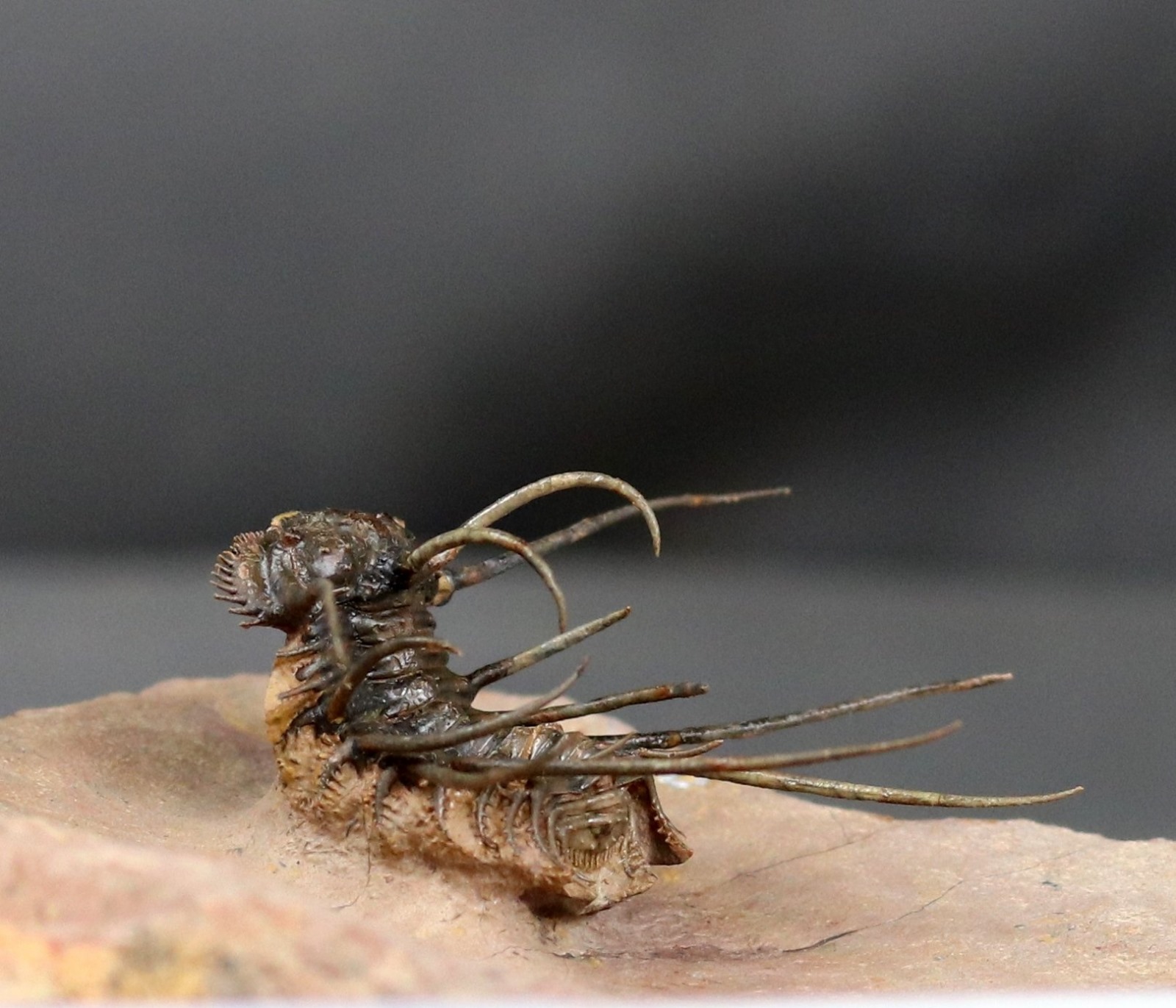
- The Upper Silurian of Gotland Island (Sweden) is renowned for its rich and particularly well-preserved fauna, including superb Trilobites. The “Hemse group” is the outcrop dating from the Ludlow period that contains these famous arthropods. Genera include Proetus, Encrinurus, Acastella, Ktenoura and Calymene. Encrinurus and Proetus are undoubtedly the most aesthetically pleasing Trilobites. The former are remarkable for their typical granular cephalic ornamentation. The associated fauna is very rich in Brachiopods, Crinoids, Cephalopods... Among the latter, the Nautiloides Peismoceras are particularly noteworthy

- The Lower Devonian of the Hunton Group in southern Oklahoma (USA) is a particularly remarkable Lagerstätte from which many aesthetically pleasing and perfectly preserved Trilobites originate. The group is made up of 3 formations, the “Haragan formation”, the “Bois d'Arc formation” and the “Frisco formation”. Most Trilobites belong to the orders Phacopida, Corynexochida, Proetida and Lichida. The genera Huntoniatonia, Kainops, Paciphacops and Lochkovella are the most prolific in terms of number of species. The genera Kettneraspis, Dicranurus, Ceratonurus, Laethoprusia and Cordania have superb ornamentation and are particularly aesthetically pleasing. Dicranurus and Ceratonurus are undoubtedly the most remarkable with their pair of long, curved occipital spines and pleural spines on the thoracic segments. Trilobites have a characteristic light caramel color on pale beige limestone, very similar to the Ordovician fauna of the St. Petersburg region.
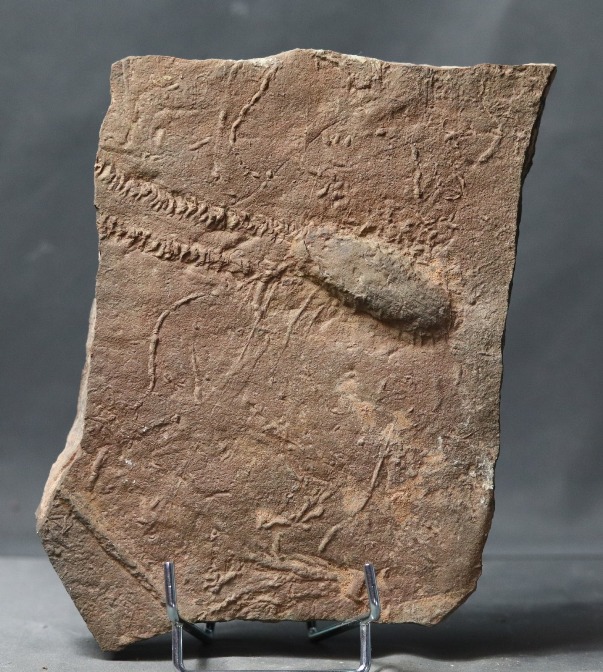
- The Lower and Middle Devonian of Morocco's Anti-Atlas region is world-renowned for its deposits, which yield a highly varied fauna comprising numerous Trilobites of excellent quality. Most of the “fake” Trilobites on sale are copies of Moroccan Devonian specimens.
Morphotypes are extremely varied, with species featuring horns, spines or even a 3-pointed fork extending the cephalon in the Walliserops genus. There are so many genera and species that it would be impossible to make an exhaustive list here, but a few particularly noteworthy ones are Erbenochile, Koneprusia, Ceratarges, Kettneraspis, Cyphaspis, Diademaproetus and Akantharges. The genera Reedops, Paralejurus or Crotalocephalus have a simpler morphology with no particular ornamentation.
You'll find a wide variety of these superb Trilobites for sale on our website.
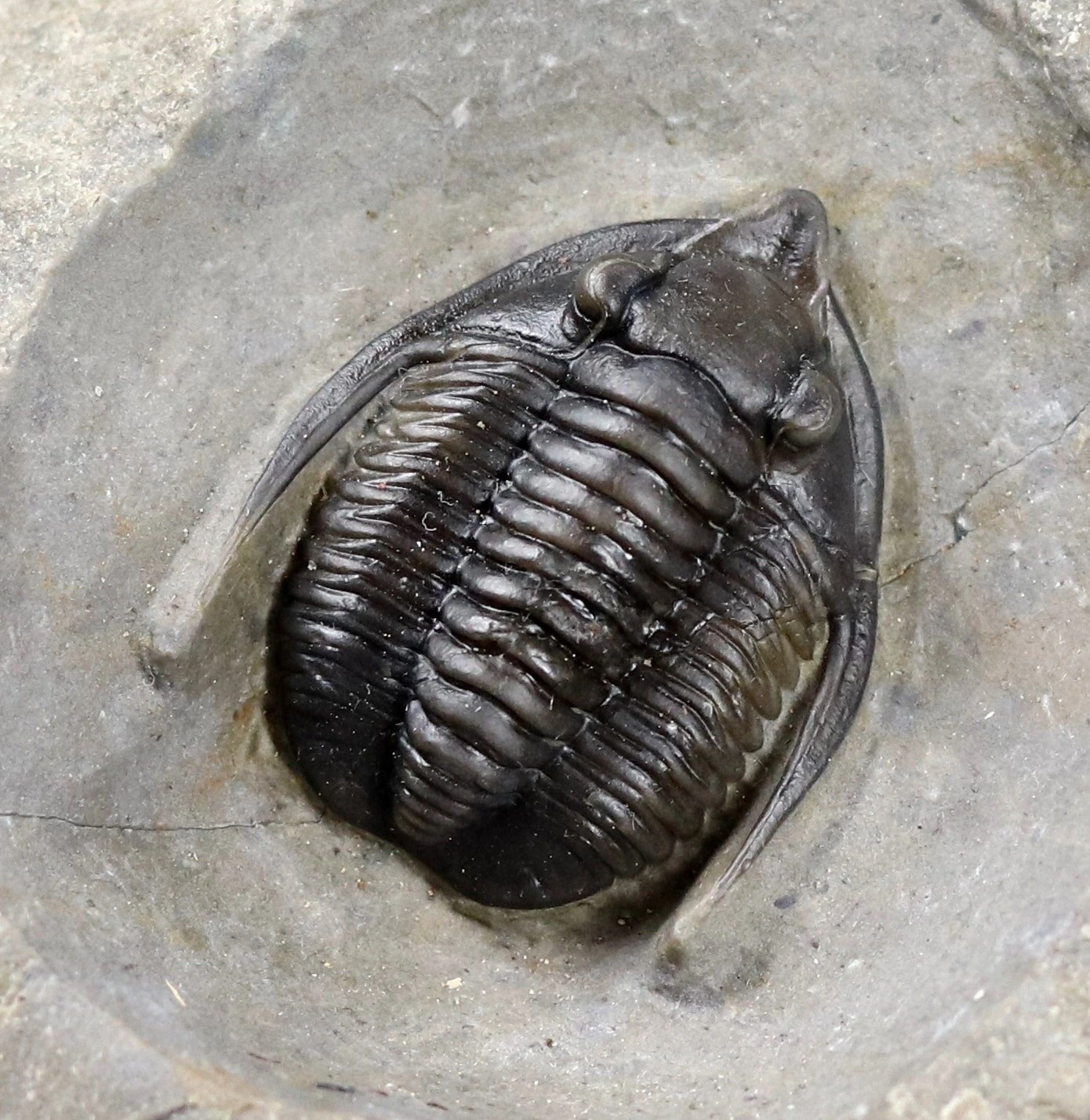
The Lower Devonian of Bundenbach in the Hunsrück mountains of Germany is an exceptional Lagerstätte deposit, not only for the diversity of the marine fauna present, but also for the perfect preservation of the fossils in pyritic form. Echinoderms make up the bulk of the fauna, but Trilobites are also well represented, with some specimens having preserved their soft parts in a fossilization reminiscent of the Upper Ordovician “Beecher's Trilobite Bed” in New York State (USA).
All four typical Devonian orders (Phacopida, Proetida, Lichida and Corynexochida) are represented. The Phacopida are by far the best represented, with some fifteen species, the most common of which is by far Chotecops ferdinandi. This species is even known from numerous specimens with fossilized soft parts, whereas the rest of the Trilobite fauna is often made up of incomplete fossils.
Other uncommon arthropods known from this Lagerstätte include Mimetaster haxagonalis, Vachonisia rogeri, Cheloniellon calmani and Nahecaris stuertzi.

- The Middle Devonian of the Eifel region in western Germany features a fauna of Eifelian age, the stage to which the region gave its name. At least 35 species of Trilobites have been described, many of which are considered endemic. The most common species is Geesops schlotheimi, followed by Gerastos cuvieri, Cyphaspis ceratophthalmus and rare members of the Asteropyginae subfamily such as Neometacanthus stellifer. Other genera include Kettneraspis, Cornuproetus and Ceratarges. Morphs are as varied as species. Trilobites are generally dark brown on a dark gray limestone or marl gangue.
- The Middle Devonian of the “Mur des douaniers” at Vireux-Molhain in the French Ardennes is today a nature reserve with an abundant Trilobite fauna, albeit limited to a dozen described species. These Arthropods alone accounted for almost three-quarters of the total benthic fauna known from the site. The orders Phacopida, Proetida, Lichida and Corynexochida are present, but the variety of species remains very limited. Known genera include Geesops, Ceratarges, Kettneraspis and Cyphaspis.
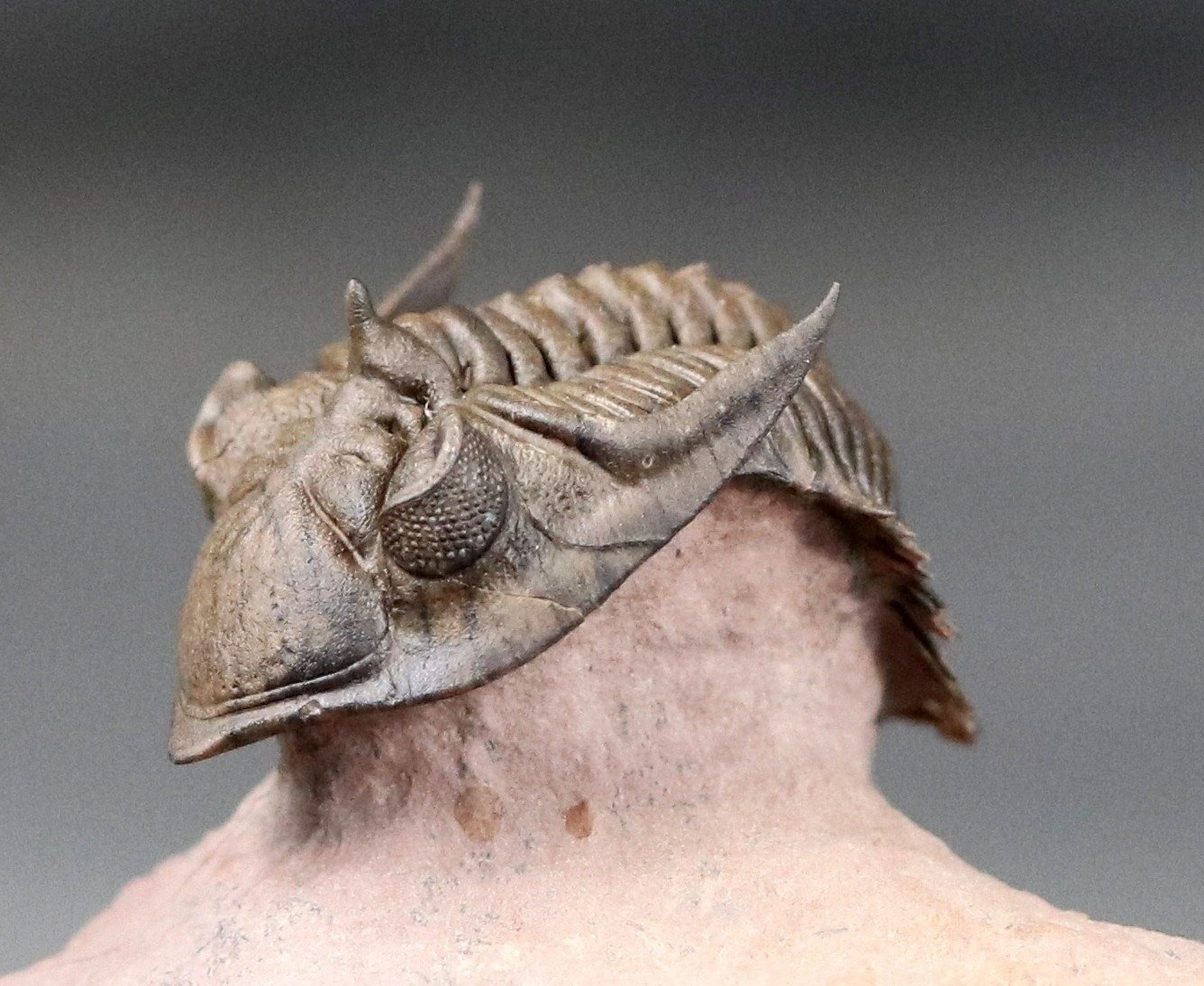
- The Lower Carboniferous around Tournai (Belgium) is famous for its Lower Mississippian (basal Carboniferous) Trilobites of Tournaisian age (a stage that takes its name from this outcrop).
The “Tournai Limestone” is made up of two formations: the “Tournai Formation”, which is the most fossiliferous and contains the region's best-known trilobites, and the “Antoing Formation”, which is much less rich. Representative genera include : Piltonia, Cummingella, Paladin, Parvidumus and Witryides.
- The Lower Carboniferous “Lake Valley Formation” in Sierra County, New Mexico (USA) is famous for its Trilobites, all belonging to the order Proetida. Just over twenty species have been described. The most representative genera are Australosutura, Griffithidella, Namuropyge, Piltonia and Thigriffides. The Lake Valley formation comprises 5 members, the best known of which is the Nunn member, which is highly fossiliferous and also contains a large Crinoid fauna.
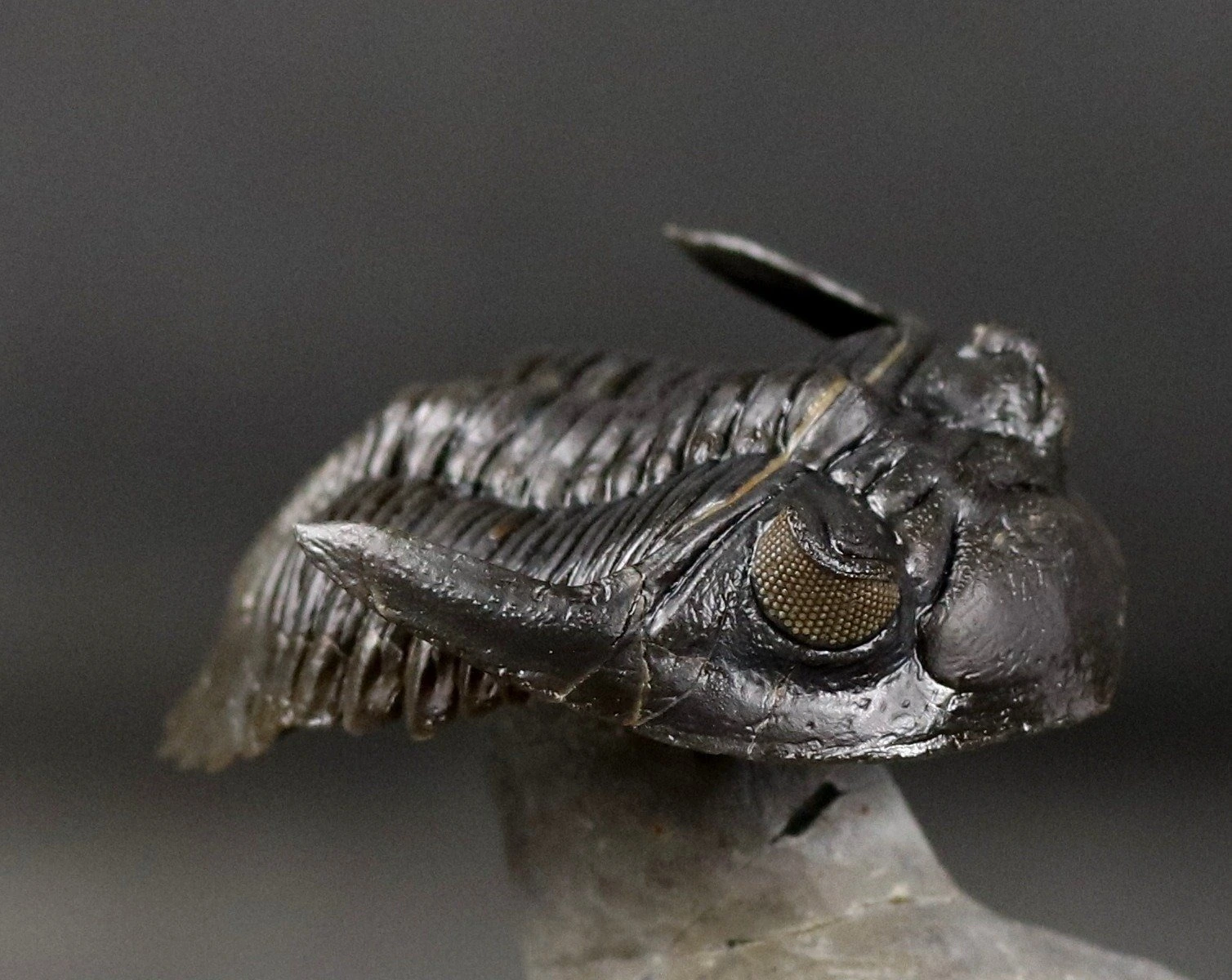
- Permian trilobites are very rare, but representatives can be found in a few deposits around the world. The Upper Permian “Sosio Formation” in Sicily (Italy) is a good example, with Microphillipsia, Proetus and Pseudophillipsia. In Russia, in the Permian of the Ural Mountains, Trilobites of the genera Pseudophillipsia and Cummingella can be found. In Timor, a few rare representatives of the Phillipsiidae family can be found in the Ammonoid levels of the Lower Permian.
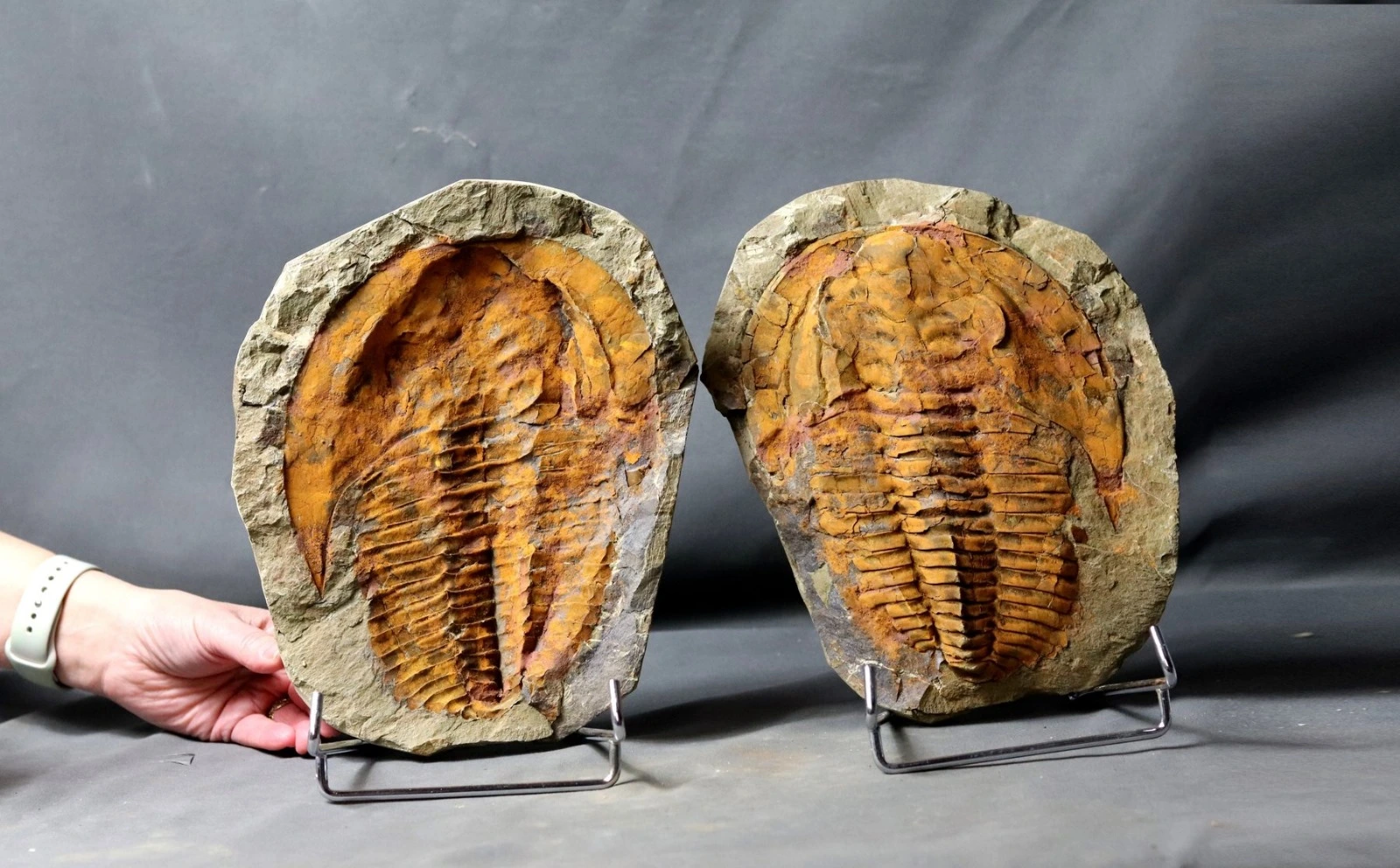
4: Trilobites, fossils often falsified
Trilobites are undoubtedly among the most frequently falsified fossils, due to the particular attraction they hold for specialist collectors, especially in the case of rare species or those with extreme morphs such as large cerci or horns. Gluing is one of the most common types of retouching. In general, a clean glue-up is not a problem. Some Trilobites are necessarily recollaged, as they can only be discovered by breaking the gangue in which they are imprisoned, and this gangue never cleaves around the fossil. The Trilobite therefore appears in several pieces that need to be reconstituted. It's also not uncommon for missing pieces to be filled in with resin, for example, which is then worked and coloured to match the color of the fossil. Sometimes these repairs are crude and easily visible, but sometimes the work is much more meticulous. Particular care must be taken with high-quality Trilobites or those that appear too “perfect”. The tips of specimens with detached appendages are rarely entirely original, as they are often broken during preparation, but you will find on our site Trilobites for sale of very high quality that are guaranteed without any restoration.
Composites are not uncommon among Trilobites; these are specimens presented as whole but are actually composed of pieces from different specimens—sometimes even from different species and genera—glued together. This practice dates back to the 19th century when people were paid to search for Trilobites in Central Europe. The payment was higher for rarer species, which encouraged them to create entirely new species from scratch and sell them at exorbitant prices.
Trilobites are among the fossils that are frequently sculpted, sometimes partially and sometimes even entirely. It is not uncommon to find Trilobites whose pygidium, genal spines, or even pleural spines have been carved out of the rock.
5 : How to check the authenticity of a Trilobite?
The examples mentioned above do not constitute an exhaustive list of “enhancement” techniques, and in all cases, it is important to remain cautious and be wary of Trilobites that seem too perfect and are offered at overly attractive prices. Sometimes, restorations are so well done that they cannot be noticed with the naked eye, but there are ways to verify them. In most cases, a simple magnifying glass can already allow for a good examination of the fossil. In Trilobites, resin can be detected by the presence of tiny bubbles and surface holes. Examining the matrix is also important; differences in color between the top and bottom of the matrix should alert the buyer. For Trilobites from Devonian limestones, microfractures naturally present on the fossil are a good indicator.
Beyond using a standard magnifying glass, a binocular magnifier with high magnification can be used for a more detailed examination of the specimen.
Resins have the characteristic of reflecting black light. Thus, resin appears shiny or even fluorescent under a UV lamp, making it immediately distinguishable from the original fossil. The UV lamp has become an essential tool for Trilobite collectors.
To remove paints and varnishes that may conceal restorations, a simple technique involves using a solvent such as acetone, which quickly removes these coatings and reveals the original fossil.
If you want to be sure that you are purchasing real ones, you can find authentic trilobites for sale on our website.
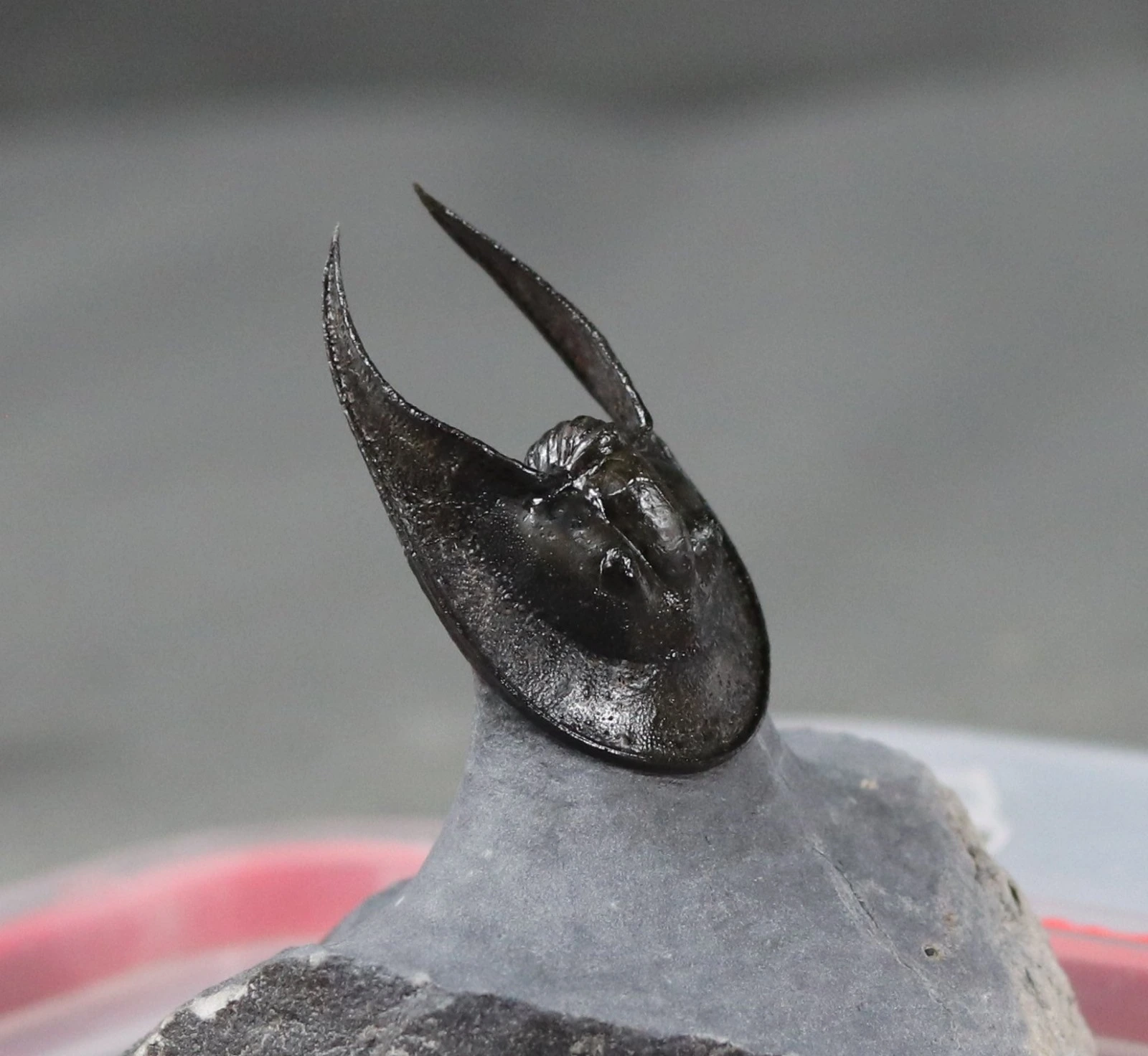
6: Conclusion
The deposits and Trilobite species mentioned in this article are by no means an exhaustive list. Considering the more than 18,000 recorded species across all eras and locations, it is easy to understand the enthusiasm of collectors, both specialized and casual, for these Arthropods. They represent an incredibly diverse fauna, with forms ranging from the simplest to the most extreme.
Furthermore, the regular description of new species, and even new genera, continues to make these key representatives of Paleozoic seas some of the most well-known and sought-after fossils among collectors.

